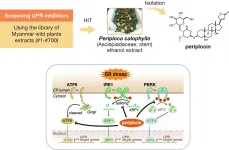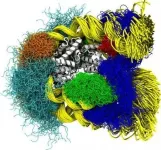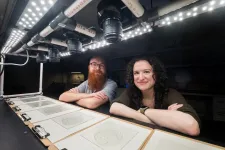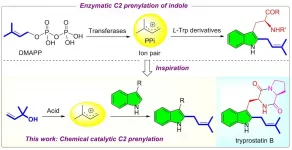INFORMATION:
Regulation of protein homeostasis by cardiac glycosides
Cardiac glycosides suppress the unfolded protein response
2021-06-07
(Press-News.org) In the present study, Dr. Hidetoshi Hayashi (Professor, Nagoya City University) and collaborators screened small-molecule compounds that suppress UPR, using Myanmar wild plant extracts library. The screening system to track X-box binding protein 1 (XBP1) splicing activity revealed that the ethanol extract of the Periploca calophylla stem inhibited the inositol-requiring enzyme 1 (IRE1)-XBP1 pathway. They isolated and identified periplocin as a potent inhibitor of the IRE1-XBP1 axis. Periplocin also suppressed other UPR axes, protein kinase R-like endoplasmic reticulum kinase (PERK), and activating transcription factor 6 (ATF6). Examining the structure-activity relationship of periplocin revealed that cardiac glycosides, basically used for cardiac insufficiency therapy, also inhibited UPR. Moreover, periplocin suppressed the constitutive activation of XBP1 and exerted cytotoxic effects in the human multiple myeloma cell lines, AMO1 and RPMI8226. These results reveal a novel suppressive effect of periplocin or the other cardiac glycosides on UPR regulation, suggesting that these compounds will contribute to the understanding of the pathological or physiological importance of UPR signaling.
ELSE PRESS RELEASES FROM THIS DATE:
Nucleosome breathing from atomistic time snapshots
2021-06-07
Researchers from the Hubrecht Institute in Utrecht (The Netherlands) and the Max Planck Institute for Molecular Biomedicine in Münster (Germany) used computer simulations to reveal in atomic detail how a short piece of DNA opens while it is tightly wrapped around the proteins that package our genome. These simulations provide unprecedented insights into the mechanisms that regulate gene expression. The results were published in PLOS Computational Biology on the 3rd of June, 2021.
Every cell in the body contains two meters of DNA. In order to fit all the DNA ...
Healthy environment, healthy kidneys!
2021-06-07
Health has always been affected by climate and weather, but is increasingly clear that the change in climate is a significant threat to human health. The World Health Organization (WHO) estimates that 24% of global deaths are linked to environmental factors [1]. Climate change and pollution can lead to undernutrition, mental disorders, and noncommunicable diseases including chronic kidney disease and acute kidney injury [2].
The burden of addressing the death and disability associated with climate change falls to nephrologists and other healthcare professionals. At the same time, the healthcare sector makes a major ...
Mechanisms of kidney protection by gliflozins
2021-06-07
SGLT2 inhibitors (gliflozins) were developed as oral antidiabetics. They enhance urinary glucose excretion by inhibiting SGLT-2 (sodium-dependent glucose co-transporter-2) in the renal tubuli. The discovery of kidney benefits beyond the lowering of blood sugar has been made by Professor Christoph Wanner from Germany: The EMPA-REG OUTCOME study [2] initially showed that the rate of cardiovascular events in type 2 diabetic pa-tients is significantly reduced if the SGLT2 inhibitor empagliflozin is administered. Kidney function in diabetics who already had diabetic nephropathy was also found to benefit sig-nificantly from the treatment ...
Popularity runs in families
2021-06-07
HOUSTON - (June 7, 2021) - If identical versions of 20 people lived out their lives in dozens of different worlds, would the same people be popular in each world?
If you substitute "fruit flies" for "people" in that question, you have a fair description of a Rice University study showing that the evolution of social structures and the positions of individuals within those structures are based partly on genetics.
Cloned fruit flies played a starring role in the study that researchers jokingly likened to "The Truman Show," with video cameras observing how the flies behaved in a controlled environment.
In the study published online this week in Nature Communications, Rice bioscientists Eric Wice and Julia Saltz ...
COVID-19: Long-term consequences for the kidneys can be expected
2021-06-07
The kidneys are a target organ of COVID-19 and are affected very early in the course. However, this is precisely where there is strong prognostic potential: As early as last spring, COVID-19-associated nephritis was identified as an early warning signal for severe courses of the infectious disease and studies to that effect were published [1]. In that regard, the research group led by Professor Oliver Gross, Department of Nephrology and Rheumatology at Göttingen University Medical Center (UMG), screened 223 patients in a study and included 145 of them as a predictive cohort. Study endpoints were ICU admission or mortality. As a result, early urinary changes ...
COVID-19 as systemic disease: What does that mean for kidneys?
2021-06-07
It was clear at a relatively early stage of the pandemic that SARS-CoV-2 causes a wide range of symptoms; in addition to typical respiratory symptoms, patients also had neurological symptoms (starting with anosmia), gastrointestinal symptoms, elevated liver values, and renal, urinary or hematological changes, for example. The fact that such findings occurred not only in severely ill patients with general organ dysfunction suggested that the virus may potentially cause disorders in various organs directly, i.e. that it causes a multi-system disease.
In spring 2020, at the very beginning of the pandemic, the authorities in Hamburg ordered autopsies be performed on all patients who had died with COVID-19. This resulted in one of the ...
Targeted COVID-19 therapy: What can we learn from autoimmune kidney diseases?
2021-06-07
Various viruses and bacteria have long been known to cause autoimmune diseases where there is such a predisposition. This phenomenon also seems to play a major role in SARS-CoV-2, especially in severe courses. The body's own immune cells are activated, with the formation of autoantibodies that attack the body's own healthy cell structures (proteins, autoantigens); deposits of immune complexes can then trigger severe inflammatory processes and cell destruction in the body.
Some nephrological diseases are likewise of autoimmunological etiology, one example being systemic lupus erythematosus (SLE), a chronic, mostly relapsing-remitting inflammatory disease with life-threatening ...
Bioinspired acid-catalyzed C2 prenylation of indole derivatives
2021-06-07
Terpenoids are omnipresent in almost all living organisms. Prenylated indoles are prominent representatives that usually display potent medicinal properties (e.g. tryprostatin B). Therefore, significant efforts have been devoted to indole prenylation over the past decades. The known protocols often require a multi-step procedure and rely on the use of stoichiometric promoters. From the viewpoint of step- and atom-economy, developing a direct catalytic C2 prenylation of indoles is highly desirable yet challenging, because the nucleophilicity of C2 site is weaker than that of other two positions ...
High caffeine consumption may be associated with increased risk of blinding eye disease
2021-06-07
Consuming large amounts of daily caffeine may increase the risk of glaucoma more than three-fold for those with a genetic predisposition to higher eye pressure according to an international, multi-center study. The research led by the Icahn School of Medicine at Mount Sinai is the first to demonstrate a dietary - genetic interaction in glaucoma. The study results published in the June print issue of Ophthalmology may suggest patients with a strong family history of glaucoma should cut down on caffeine intake.
The study is important because glaucoma is the leading cause of blindness in the United States. It looks at the impact of caffeine intake on glaucoma, ...
Pandemic prevention measures linked to lower rates of Kawasaki disease in children
2021-06-07
Research Highlights:
Rates of Kawasaki disease - a condition that creates inflammation in blood vessels in the heart and is more common in children of Asian/Pacific Island descent - have substantially decreased in South Korea during the COVID-19 pandemic.
The decrease could be due to mask-wearing, hand-washing, school closures and physical distancing, suggesting Kawasaki disease may be prompted by infectious agents.
The cause of Kawasaki disease is unknown, though it may be an immune response to acute infectious illness.
DALLAS, June 7, 2021 -- The rate of Kawasaki disease in South Korea has substantially decreased during the COVID-19 pandemic, possibly due to pandemic prevention efforts, such as mask-wearing, ...
LAST 30 PRESS RELEASES:
Making lighter work of calculating fluid and heat flow
Normalizing blood sugar can halve heart attack risk
Lowering blood sugar cuts heart attack risk in people with prediabetes
Study links genetic variants to risk of blinding eye disease in premature infants
Non-opioid ‘pain sponge’ therapy halts cartilage degeneration and relieves chronic pain
AI can pick up cultural values by mimicking how kids learn
China’s ecological redlines offer fast track to 30 x 30 global conservation goal
Invisible indoor threats: emerging household contaminants and their growing risks to human health
Adding antibody treatment to chemo boosts outcomes for children with rare cancer
Germline pathogenic variants among women without a history of breast cancer
Tanning beds triple melanoma risk, potentially causing broad DNA damage
Unique bond identified as key to viral infection speed
Indoor tanning makes youthful skin much older on a genetic level
Mouse model sheds new light on the causes and potential solutions to human GI problems linked to muscular dystrophy
The Journal of Nuclear Medicine ahead-of-print tip sheet: December 12, 2025
Smarter tools for peering into the microscopic world
Applications open for funding to conduct research in the Kinsey Institute archives
Global measure underestimates the severity of food insecurity
Child survivors of critical illness are missing out on timely follow up care
Risk-based vs annual breast cancer screening / the WISDOM randomized clinical trial
University of Toronto launches Electric Vehicle Innovation Ontario to accelerate advanced EV technologies and build Canada’s innovation advantage
Early relapse predicts poor outcomes in aggressive blood cancer
American College of Lifestyle Medicine applauds two CMS models aligned with lifestyle medicine practice and reimbursement
Clinical trial finds cannabis use not a barrier to quitting nicotine vaping
Supplemental nutrition assistance program policies and food insecurity
Switching immune cells to “night mode” could limit damage after a heart attack, study suggests
URI-based Global RIghts Project report spotlights continued troubling trends in worldwide inhumane treatment
Neutrophils are less aggressive at night, explaining why nighttime heart attacks cause less damage than daytime events
Menopausal hormone therapy may not pose breast cancer risk for women with BRCA mutations
Mobile health tool may improve quality of life for adolescent and young adult breast cancer survivors
[Press-News.org] Regulation of protein homeostasis by cardiac glycosidesCardiac glycosides suppress the unfolded protein response



